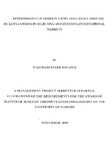| dc.description.abstract | The study set out to identify the cultural practices that are responsible for girls' early marriage among the Maasai ofKajiado District. Marriage age in Kenya has gone up to 18 years and above as a result of girls being taken to school in most parts of the country, but the practice of early and sometimes forced marriage continues to be carried out by some communities, among them the Maasai, Mijikenda, the Somali and others. This practice interrupts girls' educational pursuit and with this any hope of the benefits that accrue from education, like literacy, better job prospects and improved knowledge of running their families.
Medical knowledge has also advanced the fact that, marriage at an early age can be harmful to the girls' health as their bodies may not be fully developed for child bearing. Attempts by interested parties to intervene and save the girls from early marriage so that they continue with schooling has not had any impact on the practice.
The objectives of the study were to find out how early marnage IS influenced by cultural practices like Female Genital Mutilation, exchange of bride wealth, family economic status, and the implications of these practices on girls' educational attainment.
The study used both library and field research to obtain data. A sample of 60 adults, (30 men and 30 women) were randomly selected from Mashuru and Central Divisions ofKajiado District. Sixteen Focus Group Discussions were also conducted among pupils from four primary schools in the same divisions. More information was obtained from key informants, who comprised school administrators, District Children's Officer, teachers as well as from case histories of girls who had survived attempts to be rnarried off by their parents.
Data was analysed into cumulative frequencies and percentages using simple statistical techniques. They were presented in tables and us~d to explain the influence, trends and implications of early marriage among the Maasai of Kajiado.
The study revealed that, marriage age among the Maasai community has actually come down from the mean age of 19 to 14 years. This has come about as a result of lowered circumcision age for girls, from a mean of 17 years for the current generation of parents to the mean age of 13
years as a result of girls bodies maturing faster nowadays due to dietary changes. It was also revealed that girls in the Maasai community become sexually active quite early as the custom does not discourage it. It is, however, considered a taboo for a girl to become pregnant before she has undergone circumcision.
It was also revealed that parents who are educated are against the idea of their young daughters getting married and instead encourage them to continue with education, by taking them to boarding schools. Early marriage was found to occur more in cases where the girls' fathers do not own big herds of cattle by Maasai standards and, therefore, view the daughters' marriage as a way of increasing it from the expected bride wealth.
The study therefore, concluded that a combination of cultural practices namely female circumcision, belief and fear of taboos, as well as a changing socioeconomic environment that has resulted in faster physical maturity were responsible for the practice of early marriage.
On the basis of the findings the study recommended more government involvement that will set and enforce a minimum national marriage age for all communities. This will not only act as a deterrent to the practice of early marriage but will also assist and guide those who would like to intervene to save the girls from early and forced marriages. More research should also be carried out among those communities which practice FGM so as to find out if it is also linked to marriage, and especially early marriage. | en |

